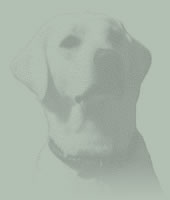We've had a lot of explanations (except from you, alas,
whom we've never before asked) about how labs "yellow," "chocolate," and "black" turn
out to be those colors. Is it really possible to have labs
of different colors in a single litter? If so, how do all
of yours seem to be yellow (i.e., "white")? Is one of the
colors a recessive trait? If we bred our lab, would there
be any possibility that he would have different-colored offspring?
Many thanks for demystifying this topic for us
Dr. DeMichael: Here's at least a partial answer
to your question:
Black coat is the dominant gene yet blacks can also carry
a gene for yellow, chocolate or both. Because of the numerous
options when the third gene (chocolate) is involved, let
me simplify by limiting the discussion to black and yellow.
Let's label the simple genes as follows:
- DOMINANT BLACK - BB
- BLACK WHO CARRIES THE YELLOW GENE - Bb
- YELLOW - bb
Remember, that the chocolate gene may be carried by any
of the above dogs as well, but this would require a more
extensive discussion.
Acknowledging that one gene will be passed on from the
sire and one from the dam of any particular mating, we
have the following possible outcomes of a mating:
i) Breeding a BB (dominant black) to a BB (dominant black)
will always produce black pups with a BB genetic makeup.
None of these pups will carry anything but the black gene
because the mother and father each, because they are BB,
can only pass on the B gene.
ii) Breeding a BB to a Bb (a black dog who carries the
yellow gene) will produce 50% BB pups and 50% Bb pups.
While half of this litter will carry the yellow gene, (those
that are Bb), all will be black coated because black isdominant.
iii) Breeding a Bb to a Bb will produce pups with the
following genetic make-up. 25% will be BB - and exhibit
the dominant black coat 50% will be Bb - a black dog that
carries the yellow gene 25% will be bb - a yellow dog
iv) Breeding a bb to a bb (true yellow to true yellow)
will produce 100% bb pups, all of which will be yellow.
Such is the case with Bainbridge Labradors.
All of the above combinations would produce Labradors
with black pigmentation, regardless of the coat color being
yellow or black. The "fly in the ointment" can occur when
the chocolate gene is introduced into this formula. For
example, let's say you have a yellow dog (for the sake
of this description, let's use YY as true yellow) who carries
the chocolate gene and call it Yc. When a Yc dog is bred
to a Yc dog, as you might expect, you would get 25% YY
(true yellows) 50% Yc (yellows that carry the chocolate
gene) 25% cc (yellow that carries NO BLACK PIGMENTATION!)
While this is simplified, the point is this: The cc combination
(often referred to as a "dudley") is very undesireable
as they have a lack of the black pigmentation. There are
certain combinations where a dog may be black yet carries
the recessive yellow and chocolate genes. Without going
through the lengthy graphic illustrations, when two of
these dogs (blacks that carry both yellow and chocolate)
are mated, the possibility exists where a dudley may also
be produced. (The probability for this would work out to
be one fourth of 25% or approximately 6% of that given
litter).
I am not here to say that a "dudley" is a bad dog. He/she
may be a great family companion. To the best of my knowledge
there are no known adverse genetic traits "linked" to the
dudley other than the lack of pigmentation. (Remember a
dudley is not an albino). It is my opinion that a well
bred yellow or black Labrador should be black pigmented
and I would take the appropriate steps to prevent producing
a "dudley".
Your dog may most likely be characterized as a bb (in
the first example) or as a YY (as in the second example).
I'm going to end here before I confuse both of us any
more than I already have!



